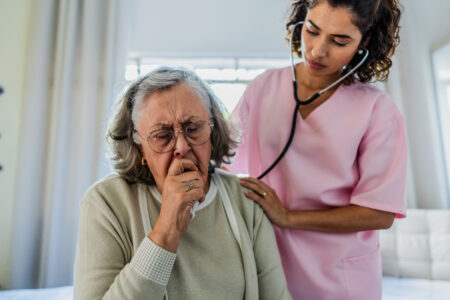
Share On Social!
Do you realize how many things you touch with your hands every day?
When we touch anything from our phones to our doorknobs, we can pick up germs like bacteria, fungi, and viruses. Germs can get in between our fingers or under our fingernails where it’s warm and damp, or in cuts on the skin, and grow and spread quickly, causing illness.
That’s why hand hygiene and cleaning your hands is an important for infection control for frontline healthcare workers.
“The simple answer is, when you clean your hands, you’re stopping the spread of germs to your patients, to the environment, and to the things in the environment and from your patients or the environment to you,” said Dr. Abigail Carlson, an infectious diseases physician with the CDC, as part of CDC Project Firstline’s Inside Infection Control video series.
Why is Hand Hygiene Important
Wash your hands before dinner. Wash your hands after using the bathroom.
We’ve all heard these commands.
That is because every person touches a lot more things with their hands than they might think, and germs can be found in many of those things.
 Germs can stick to your hands and be carried around, including:
Germs can stick to your hands and be carried around, including:
- Viruses like COVID-19
- Bacteria like aureus and C. difficile
- Fungi like auris
“When we use our hands, stuff gets on them. And that’s in addition to the stuff that is already on them,” Dr. Carlson said in the video series.
“So when we touch the next thing, whatever’s on our hands can get on that thing. And whatever is on that thing is going to get on our hands. It’s a big way to say that germs are everywhere, at work in the healthcare setting, but also at home and in the community when you’re running your errands and doing your shopping. It’s why there are so many messages for everyone to keep their hands clean.”
Why is Hand Hygiene Important for Infection Control?
For frontline healthcare workers, hand hygiene, or cleaning your hands, is especially important.
“We’re caring for patients who are ill and weak, and they are more vulnerable to infection. So we want to make sure we don’t spread germs to them,” Dr. Carlson said. “And at work we’re more likely to come into contact with blood, body fluids and other things that may be carrying germs constantly throughout the day.”
Take a nurse, for example.
A nurse may touch up to 15 different surfaces during a single patient interaction.
“For the average nurse, that is 912 different surfaces in a 12-hour shift,” Dr. Carlson said. “Every one of those surfaces has germs on it. So from that standpoint, it makes sense why cleaning your hands and using gloves correctly are so important.”
How Can You Help Stop Germs from Spreading in Healthcare Settings?
Start by practicing good hand hygiene.
“Washing your hands removes dirt, removes some germs, [and] even might kill some germs,” Carlson said. “And alcohol-based hand sanitizer kills the germs.”
Healthcare workers can access more information about infection prevention and control in healthcare by visiting resources from Project Firstline.
Project Firstline creates resources, including videos and shareable images, web buttons, posters, and print materials. They also have facilitator toolkits to help workers lead trainings even if they are not an infection control expert.
Salud America! at UT Health San Antonio is working with the National Hispanic Medical Association to bring CDC Project Firstline infection control educational content to healthcare workers, so they are equipped with the knowledge they need to protect themselves, their facilities, and their patients (from Latino and all communities) from infectious disease threats in healthcare settings.
You can read these articles:
- What is Project Firstline?
- What is a Virus?
- How Does Infection Control Work on COVID-19 Variants Like Omicron?
- Contact Time: What is It and How Does it Impact Infection Control?
“I think there’s probably not a single healthcare worker in the country that thinks hand hygiene is bad. But I do think that there are people who may not think about all of the times they need to do that,” Dr. Michael Bell, Deputy Director of the CDC’s Division of Healthcare Quality Promotion, told Infection Control Today.
“An example is cleaning your hands before putting on non-sterile gloves. A lot of people will react to that and say, ‘Well, I’m putting on gloves. So why do I need to clean my hands? I’ll clean them as soon as I’m done and take my gloves off.’ But the rationale is if you’ve got something on your hands, and you reach into a glove box, a box of clean gloves, and contaminate them, not only are you then contaminating the gloves you’re putting on, but you’re contaminating other gloves that other healthcare workers are going to have to reach in to use. Putting both them at risk, and their patients.”
Editor’s Note: This article is part of a collaboration between Salud America!, the National Hispanic Medical Association, and the CDC’s Project Firstline. To find resources training materials, and other tools to bolster knowledge and practice of infection control, visit Project Firstline and view Salud America!’s infection control content.
Explore More:
Infection ControlBy The Numbers
142
Percent
Expected rise in Latino cancer cases in coming years



